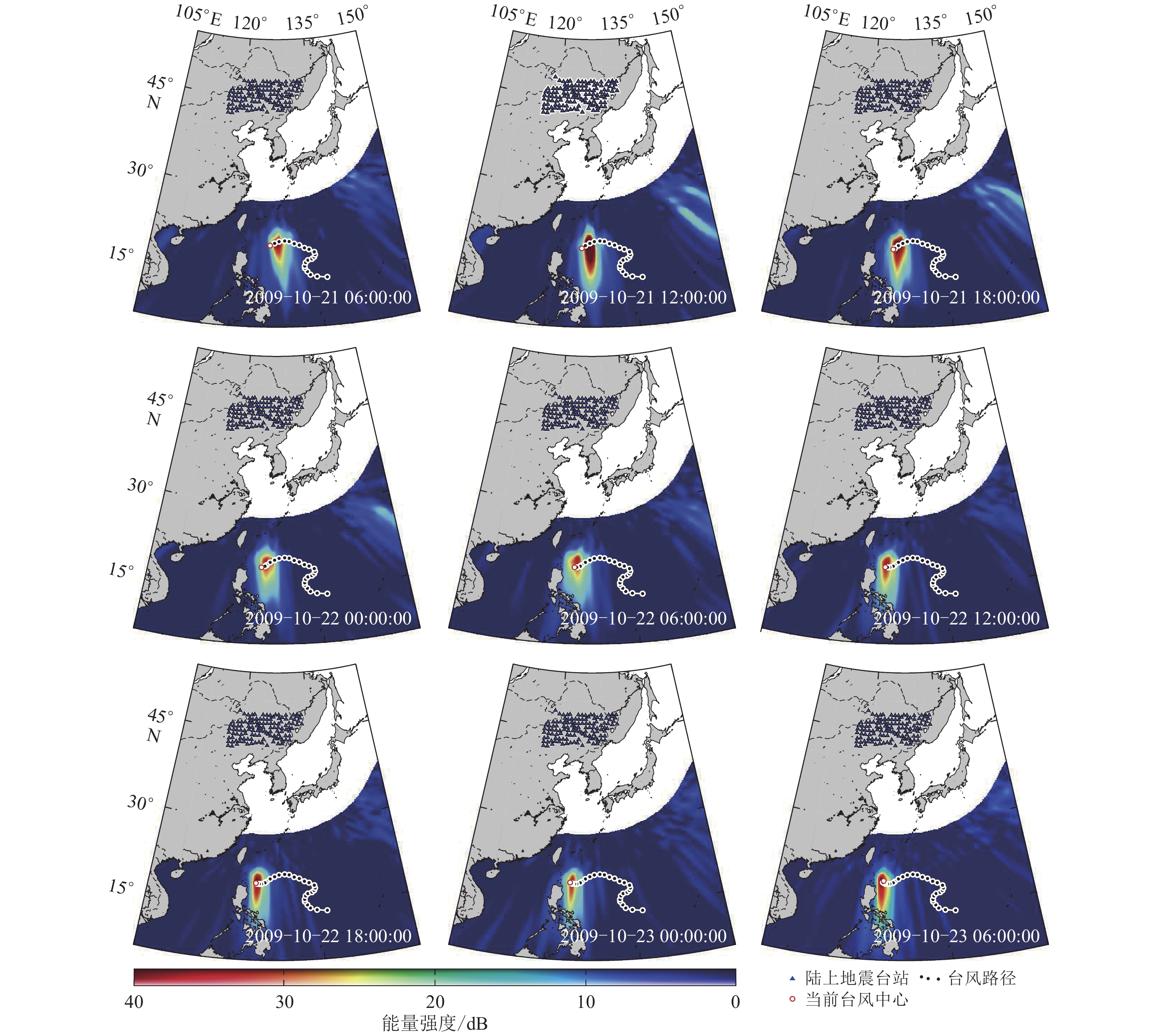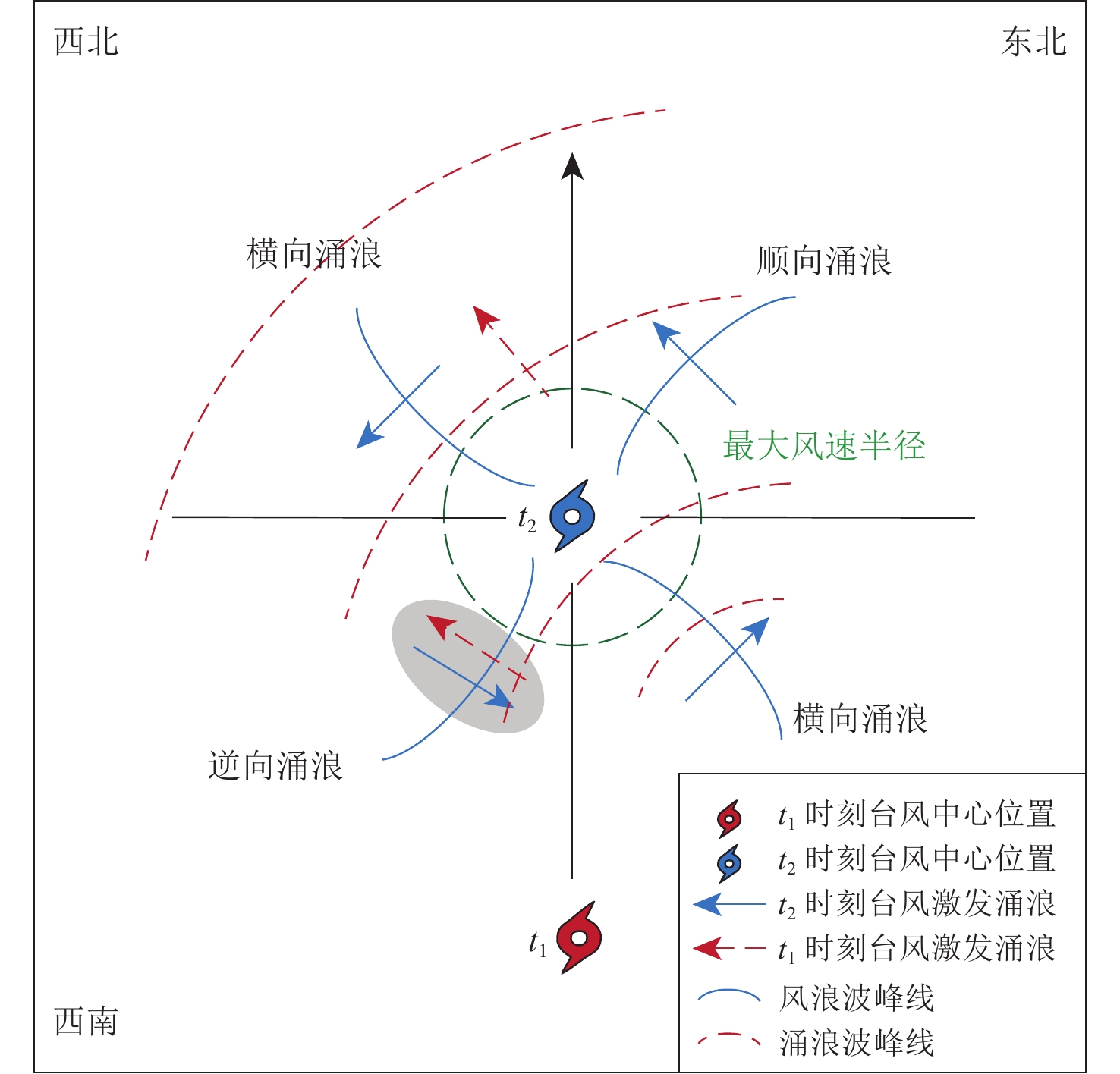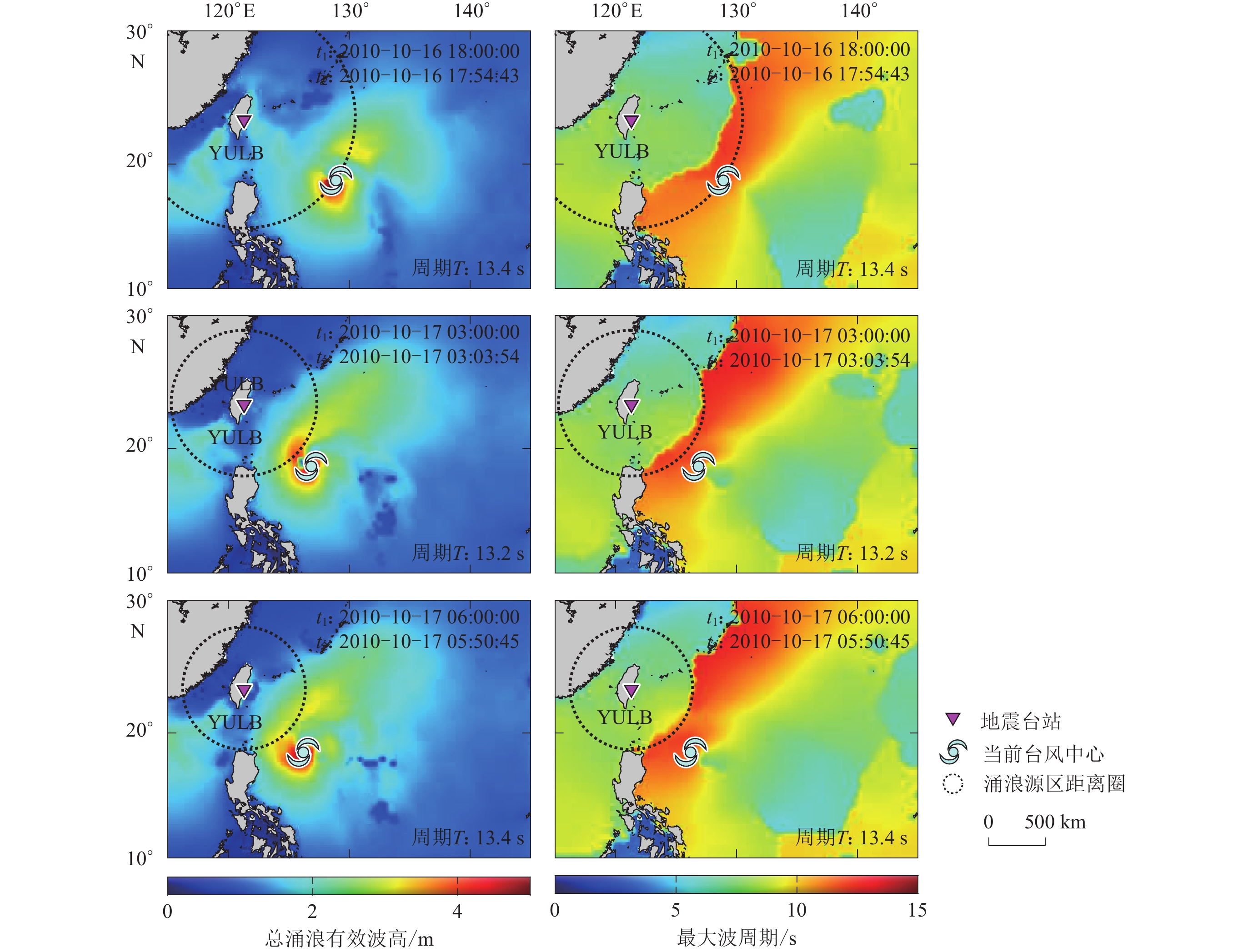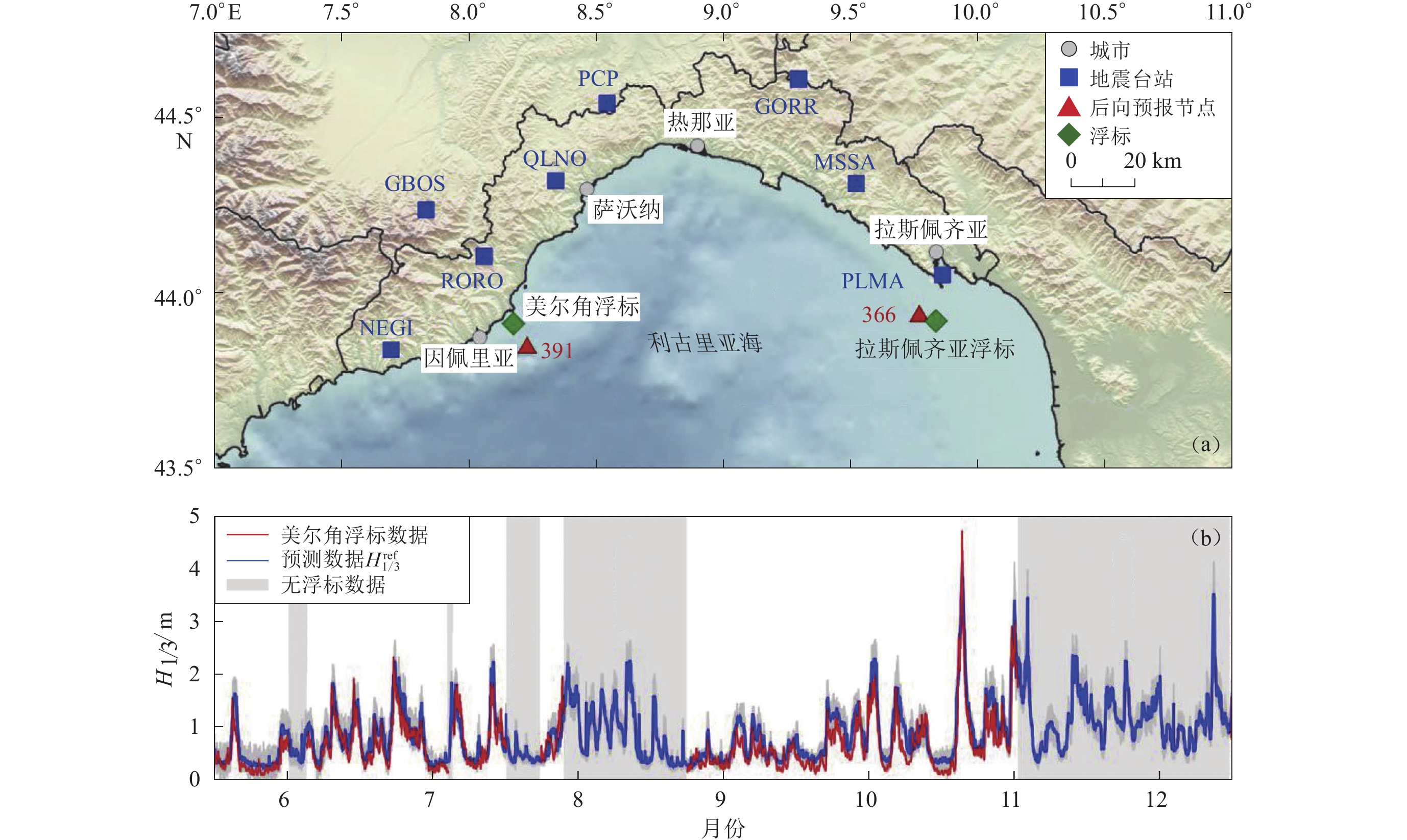Seismic monitoring of typhoons based on seismology
-
摘要: 台风是全球最具破坏力的气象灾害之一,由于台风过境时现场海洋观测资料相对匮乏,与目前对台风的监测、预报和防灾减灾的迫切需求尚不相匹配。近年来,利用地震学观测资料与技术手段,通过台风激发的地震背景噪声,对台风进行监测的新方法逐渐兴起。本文对近年来有关台风激发地震背景噪声机理、源区分布以及基于地震背景噪声的台风定位追踪、海浪参数反演等研究进展进行综述,分析已取得的研究成果及可能存在的问题,讨论并展望基于地震学的台风监测研究思路与热点。基于地震学的台风监测有望为传统台风观测与研究提供跨学科的观测资料与技术支持。Abstract: Typhoons are one of the most destructive meteorological disasters all over the world. However, because of the lack of in situ observations under such extreme weather conditions during the typhoon’s passage, typhoon monitoring and forecasting are still not able to meet the needs of typhoon prevention and mitigation. In recent years, a new method of typhoon monitoring based on seismological observations and techniques has emerged and developed, utilizing typhoon-generated seismic noise as a proxy. This paper reviews the recent progress in study of typhoon-induced microseisms, including the generation mechanisms, source location distribution, and its potential implications on typhoon monitoring and ocean wave parameter inversion. Future prospects on seismic monitoring of typhoons are provided and discussed. This newly emerging method may provide interdisciplinary support to traditional observation and investigation of typhoons.
-
Keywords:
- typhoon /
- ambient seismic noise /
- microseisms /
- seismic array /
- beamforming
-
引言
地震计是地震动波形数据采集系统中最重要的部分,不同地震计之间的对比研究是很多研究人员感兴趣的课题。目前国内用于地震观测的地震计有多种(刘瑞丰等,2008),这些地震计所记录数据之间的一致性值得深入研究。
一般来说,地震计的记录特性可以用传递函数来表述,因此,仪器参数的对比基本上可以反映出不同地震计之间的性能差别。但不同地震计的实际观测差别却不容易通过仪器参数的对比直观地看出或者定量地得到。地震计记录的信号包括地震、爆破信号、地脉动信号、环境噪声(气流、海浪、人文等噪声)、环境参数(气压、温度等)变化引起的噪声以及地震计内部噪声,有时环境参数改变引起的噪声也被划归为仪器噪声。地震计之间的实际观测差异一方面来自于仪器噪声的差异,另一方面,因为对相同外部信号记录的不一致性,在实际观测中这些差异耦合在一起,使不同地震计在观测频带范围内呈现出各自的记录特性,从而可能影响到波形分析结果。例如,对于长周期地震计来说,低频范围内的数据常被用于基于接收函数、噪声成像等方法的地球自由振荡研究,而这一频率范围内的记录由于常受到气流、温度和气压的变化及地倾斜等因素的影响,导致不同地震计的记录存在一定的差别。在数据处理时,如果对不同地震计的观测差别有直观的、量化的认识,则可以更合理地选择适宜的数据处理方法。
本文拟对比两种宽频带地震仪器所记录波形的噪声概率密度函数(probability density functions,简写为PDFs),以期定量地观察不同仪器观测性能之间的差异,以便深入理解仪器参数与观测性能之间的关系。
1. PDF方法
1.1 PDF简介
PDF统计法是由Mcnamara和Buland (2004)于2004年首次提出,是基于传统的噪声功率谱密度(power spectral density,简写为PSD)分析方法,利用长时间内完整连续的波形记录分析地震观测台站噪声水平的方法。该方法区别于传统PSD方法之处在于,其在计算中不需要排除包括地震在内的突发事件,也不必刻意地选取外界噪声较小的时段来计算PSD,而是对所有记录数据进行相同处理,因此可以在保持数据连续性的同时,将各种对背景噪声的影响体现在PDF的概率值中,使得该方法包含了地震计对所有地表振动的记录,全面地反映出台站的噪声水平。这一方法近年来已被越来越多的国际同行应用,在美国该方法已被应用于美国地震学合作研究会(Incorporated Research Institutions for Seismology,简写为IRIS)和美国国家地震监测台网系统(Advanced National Seismic System,简写为ANSS)的数据管理和流动台阵观测数据质量控制(Mcnamara,Boaz,2005;Diaz et al,2010)。国内,PDF方法越来越多地被用来评估测震台站数据的观测质量,例如:吴建平等(2012)利用PDF方法分析了华北地区的背景噪声,得到了华北不同地区的背景噪声特征,并提出基于PDF分析的环境噪声特征可以对流动台阵的数据观测质量进行定量评估;葛洪魁等(2013)通过对不同台基的台站背景噪声进行PDF分析,提出了流动台阵观测的有效降噪方法。
PDF的计算方法可概述为:首先将一个较长时段的数据记录分成连续的若干段,以方便对每一段数据进行PSD计算;然后将所有的PSD计算结果进行概率统计,即统计出在某一频率,各功率谱密度值在所有可能出现的功率谱密度值中所占的比例,其计算方法为
$P\left( {f,d} \right) {\text{=}} \frac{{{N_{df}}}}{{{N_f}}}{\text{,}}$


(1) 式中:P(f,d)表示频率为f、功率谱密度为d时的概率密度;Ndf表式频率为f时,功率谱密度在[d,d+δd] dB范围内出现的次数;Nf表示频率为f时,各功率谱密度值出现的总次数。
1.2 数据处理过程
具体计算步骤为:① 用SAC软件(黄金莉,顾小虹,2001)去除地震波形记录的均值和线性趋势,再去除仪器响应,得到速度记录(单位:m/s);② 将每小时的波形数据分为14段,每段数据的长度为1 000 s (即数据段重合率为80%),用以减小PSD的方差;③ 对每一段数据进行汉宁(Hanning)窗加窗处理,以压制PSD计算时的旁瓣影响,并利用功率谱修正周期图法进行PSD计算;④ 对每小时14段PSD结果进行平均,得到该时段的PSD均值;⑤ 对PSD均值结果进行1/10倍频程滤波,得到对数坐标下均匀平滑分布的速度PSD;⑥ 将各频率对应的PSD值转换为以dB为单位,统计各频率PSD的概率分布,得到两套仪器所记录波形的PDF结果;⑦ 绘制PDF结果图,并与全球地震背景噪声模型(Peterson,1993)的新低噪声模型(new low noise model,简写为NLNM)和新高噪声模型(new high noise model,简写为NHNM)进行对比,以便直观地了解两套仪器在各频段所记录噪声的分布情况。这两个模型是Peterson在定量地分析了全球75个固定地震台站的背景噪声功率谱密度后得到的。
在实际资料处理过程中,本文选取了两套仪器自2011年11月1日至2012年10月31日一整年的记录波形,按照上述数据处理过程对数据进行处理,并绘制PDF结果。
2. 利用PDF对比地震计特性
地震计在工作中会受到各种因素的干扰和影响,两台地震计在同一观测环境下记录到的波形也会存在一定的差别,这种差别可以体现出地震计不同的观测性能,还可以用来评估某一地震计是否能够维持正常工作。一般来说,不同类型、不同厂家的地震计,或者同一类型、不同工作年限的地震计,其记录波形均可能出现一定的差别。仪器参数的对比往往不能够细致地体现出这些差别,而PDF对比则可以给出定量的对比结果,这种对比结果可以帮助我们了解观测环境对不同地震计的影响程度,进而对观测数据进行评估,并可根据不同的观测条件和需求选择相应的地震计。
2.1 资料
因为宽频地震观测实验和壳幔速度研究项目“深部探测技术与实验研究”(SinoProbe)的开展,中国地质科学院地质研究所和中国地震局兰州地震研究所在甘肃省合作市测震台网的固定台站上架设了宽频带流动观测仪器,架设周期为2011年10月至2012年12月。在此期间,固定台和流动台的仪器并行观测,二者均位于基岩山洞内,且放置在同一水泥摆墩上,均采取了防风保温等措施,观测环境非常一致,良好的观测条件保证了其观测数据的质量。表1列出了观测仪器的主要参数,可以看出,这两套仪器均适合于长周期观测,且其记录特性优良;两套设备从仪器参数到观测参数虽然存在一定的差别,但这些差别恰好可以帮助我们衡量PDF方法能否体现出两套仪器观测性能的细微差别,从而体现出仪器参数不能提供的信息,进而对仪器观测性能有更为具体的认识。
表 1 观测仪器的主要参数Table 1. Main parameters of the observation instruments台站类型 数采型号 数采字长/bit 数采动态范围/dB 地震计型号 地震计频率范围 地震计动态范围/dB 采样率/sps 固定台 EDAS-24 24 >135 BBVS-60 40 Hz—60 s >130 100 流动台 REFTEK-130 24 >135 CMG-3T 50 Hz—120 s >140 50 2.2 仪器波形记录
为确保两套仪器正常工作,我们选取一次远震和一次近震的波形记录分别进行对比,对所有波形记录均去中值和去仪器响应。考虑到仪器可能存在方位角不完全一致的问题(陈继峰等,2016),为避免这种不一致带来的水平分量的波形差异,我们先将两台地震计各自的东西分量和南北分量合并为不考虑矢量方向的水平向记录。从两次地震的原始记录波形对比中可以看出,两套仪器所记录的波形走时曲线和幅值的一致性均非常高,差别细微,各震相的相位无明显差别(图1)。
![]() 图 1 流动台和固定台不同分量的地震波形记录对比(a)和(b)分别为远震的垂直分量和水平合并分量; (c)和(d)分别为近震的垂直分量和水平合并分量Figure 1. Comparisons of seismic waveforms for different component between the mobile station and the fixed station(a) and (b) are vertical component and synthesized horizontal component of distant earthquake, respectively;(c) and (d) are vertical component and synthesized horizontal component of near earthquake, respectively
图 1 流动台和固定台不同分量的地震波形记录对比(a)和(b)分别为远震的垂直分量和水平合并分量; (c)和(d)分别为近震的垂直分量和水平合并分量Figure 1. Comparisons of seismic waveforms for different component between the mobile station and the fixed station(a) and (b) are vertical component and synthesized horizontal component of distant earthquake, respectively;(c) and (d) are vertical component and synthesized horizontal component of near earthquake, respectively进一步对上述两套仪器的近震和远震波形记录进行互相关计算,在计算前将所有波形均进行0.02—20 Hz的带通滤波处理。近震波形的长度为20 s,选取相关窗长为1 s;远震波形的长度为2 400 s,选取相关窗长为10 s。从互相关结果(图2)中可以看出:无论垂直分量还是水平分量,近震波形在S波到达之前均有一定的差异,而在S波到达之后差异较小,这种差异可能是由于地震波传播过程中微小的路径差异所造成的;对于远震记录,其在面波部分存在一定差异,水平向的差异较垂直向小。通过近震和远震波形资料的对比可以看出,两套仪器运行正常,波形记录效果均很好。
![]() 图 2 流动台和固定台不同分量地震波形记录的相关分析结果(a)和(b)分别为远震垂直分量和水平合并分量; (c)和(d)分别为近震垂直分量和水平合并分量Figure 2. Cross-correlations of different component seismic waveforms of the mobile station and the fixed station(a) and (b) are vertical and combined horizontal component of distant earthquake respectively;(c) and (d) are vertical and combined horizontal component in near earthquake respectively
图 2 流动台和固定台不同分量地震波形记录的相关分析结果(a)和(b)分别为远震垂直分量和水平合并分量; (c)和(d)分别为近震垂直分量和水平合并分量Figure 2. Cross-correlations of different component seismic waveforms of the mobile station and the fixed station(a) and (b) are vertical and combined horizontal component of distant earthquake respectively;(c) and (d) are vertical and combined horizontal component in near earthquake respectively2.3 PDF对比分析
由于两套观测仪器的观测环境非常一致,因此用PDF方法可以去除单次波形记录对比中存在的偶然性,从而可以看出两套仪器在对比频率范围内的记录差异。图3为利用两套仪器在相同观测时段(2011年11月1日至2012年10月31日)的波形数据绘制的PDF对比图,周期范围介于20 Hz—50 s之间,以确保两套仪器均处于速度平坦响应的范围内。
图3中对各台站的PDF结果均计算了均值和中值,可以看出,中值更接近实际的功率谱概率密度最大值。对比两个台站的垂直分量和南北分量的PDF中值,同时对两套仪器的仪器噪声(Ringler,Hutt,2010)进行对比(图4),可以看出:两套仪器的PDF中值相似度非常高,仅在周期小于0.1 s (10 Hz)以及大于10 s范围内略微有差别;两套设备的仪器噪声均非常低,BBVS-60的仪器噪声相对更低,两套仪器的环境噪声在全频段均远远高于仪器噪声。
2.4 PDF差异及讨论
地震仪器记录的信息包括地面运动信息和仪器噪声,在PDF对比分析时,也可以采用“环境背景噪声(包括环境噪声、干扰和地震事件)+仪器噪声”的模型来进行解释。在地震计速度平坦输出的频率范围内,仪器所记录地震动的振幅远大于仪器噪声;在速度平坦频率范围之外,这种差别将明显减小(Mark et al,1990)。在本文计算PDF所涉及的频率范围内,仪器噪声也远低于背景噪声,因此噪声功率谱得到的结果主要反映了仪器对环境背景噪声的记录情况。
大体上,可以将仪器记录的背景噪声的频率范围分为高频(1 Hz以上)、低频(1—10 s)和长周期(10—50 s) 3个部分。前人的研究表明:高频部分的干扰主要以人类活动等为主,这种干扰随距离的衰减最快,另外气流以及地方震等自然因素也会形成高频干扰(Mcnamara,Buland,2004);低频部分的干扰主要来自微震噪声,微震噪声与海底压力扰动和气流及气流引起的植物根茎扰动等有关,其主要峰值的形成一般认为与海洋波与海底或海岸线的非线性相互作用引起的海底压力扰动有关(Longuet-Higgins,1950;Frontera et al,2010 ),此外中远震也会影响到这一频率范围的背景噪声;长周期部分的噪声则主要与自然因素相关(Bonnefoy-Claudet et al,2006 ),如风、急流(瀑布和河流)、温度变化、气压变化和地倾斜等,其中地倾斜使重力耦合至水平分量中,因此水平分量的长周期噪声会高于垂直分量(Wielandt,2002);此外各类远震波也在低频和长周期范围影响背景噪声。
从两种仪器的背景噪声PDF中值和仪器噪声对比来看:当周期在0.1 s以上时,两者的仪器噪声差异超过了背景噪声差异;当周期处于10 s以上的低频范围时,两种仪器的背景噪声PDF中值出现一定的差别,即固定台站的中值相对略低,这一频率范围内PDF概率密度分布则出现较为明显的差别,流动台站的概率密度分布相对较为聚拢;在周期小于0.1 s的频率范围内,二者的仪器噪声水平非常相近,但固定台站的PDF中值相对较低,二者的PDF概率密度分布并未出现明显差别,因此可以推断,这种差别源于仪器记录背景噪声幅值的差异。
为了更好地观察不同频率处两套仪器记录背景噪声的差别,我们以垂直分量为例,观察PDF中0.06 (16.7 Hz),0.1 (10 Hz),1,10,30和40 s等频率处的概率分布细节(图5)。可以看出:① 在0.06 s处,两套仪器的PSD分布的整体形态一致,但二者的PSD值存在一定偏差,说明两套仪器在这一频段记录的环境噪声是一致的。由于两套设备的仪器噪声大小在这一频率处相当,因此,PSD分布的偏移则反映出两套观测仪器在该频率处的灵敏度的实际细微差异,这一差异从仪器参数中并不能直接看出;② 在0.1,1,10 s等3处,两套仪器的PSD分布几乎完全一致,说明两套仪器的记录特性在这一频率范围内的一致性非常高。反观二者的仪器噪声则存在一定差异,考虑到仪器噪声的幅值远小于背景噪声的幅值,说明仪器噪声的差异并不影响到背景噪声的记录;③ 在30 s和40 s处,两套仪器的仪器噪声存在差异,固定台的相对较低。背景噪声也存在一定差异,不过,相较于背景噪声PDF中值(接近PSD峰值)的差别,其PSD分布差别较大,主要体现在PSD分布形态,固定台的分布更宽,流动台则较为聚拢。结合仪器噪声幅值,可以看出在这一频率,虽然固定台的仪器有更低的仪器噪声,但其对于外界因素的影响更为“敏感”,从而表现出更大的PSD变化范围,而流动台站的PSD值分布则较为集中。
在地震观测系统中,数据采集器对于记录背景噪声的影响很小,而本文中两台数据采集器的工作参数也非常接近:均为24位高精度AD转换,动态范围大;工作温度均介于−20—60 ℃之间;GPS精度均小于±100 μs;数据采集器增益为1时,自身工作引起的噪声水平均约为1个计数(1个计数对应地动速度小于0.001 6 μm/s),因此,数据采集器对于PDF结果的影响极小,两套仪器记录的差异主要来自于地震计。地震计是受外界干扰影响的主要部分,诸如温度、气流、地倾斜等干扰因素对于地震观测系统的影响主要作用于地震计。如前文所述,地震计的仪器噪声大致可以分为地震计内部噪声和仪器受环境参数(气压、温度等)变化引起的噪声。对于速度地震计来说,地震计内部噪声主要包括换能器放大器的电子噪声和机械摆体的布朗热噪声(崔庆谷,2003)。本文选取的两种地震计均采用电容位移换能器,这是由于相较于速度换能器,位移换能器在噪声抑制方面有优良的性能(崔庆谷,2003),因此,两种地震计在换能器电子抑制噪声方面均有很好的效果。机械摆体的布朗热噪声大小由8πKbTe/QT0ms决定,其中Kb为玻尔兹曼常数,Te为开尔文温度,Q为摆体的品质因子,T0为摆体的自振周期,ms为摆体的等效质量。Q,T0和ms共同决定了机械摆体的布朗热噪声的大小。相对于地震计的内部噪声,环境参数变化引起的噪声往往要大得多,摆体受气压变化引起的噪声振幅有时比地面震动的振幅还要高几个数量级(Wielandt,Streckeisen,1982);另外,虽然诸如地震的计恒温观测系统在不断改进(孙宏志,2016),但温度和地倾斜引起的噪声同样也是不容忽视的(崔庆谷,2003),这些环境参数变化引起的噪声也与摆体的Q,T0和ms等地震计参数有关。水平向的摆体特别容易受到地面形变和地倾斜的影响(段天山,袁顺,2011),垂直方向的摆体由于处在非真空环境中,更容易受到气压的影响。在30—40 s频率范围内,气压、温度变化等正是影响观测的主要因素,因此,两种仪器的PDF在低频范围的差别与各自不同的Q,T0和ms等地震计参数有很大关系。结合图5e,f可以看出,固定台BBVS-60型地震计在30—50 s范围内受自然因素的干扰而引起的背景噪声变化范围较流动台CMG-3T型地震计更大,CMG-3T型地震计在此频率范围内的记录变化范围较为集中。
从两台地震计零极点描述的传递函数来看,BBVS-60型地震计给出的零点为0,0和−200.5,极点p1,p2,···,p6分别为−0.074 5+0.074 5i,−0.074 5−0.074 5i,−100.65+264.63i,−100.65−264.63i,−134.3,−493.7。CMG-3T型地震计给出的零点为0和0,极点为p1=−0.037 01+0.037 008i,p2=−0.037 01−0.037 008i。根据各极点的具体值可知,p1和p2为闭环主导极点,系统特性主要由零点及p1和p2组成的二阶系统描述,因此,二者的传递函数均可表示为
$H\left( s \right) {\text{=}}\frac{{k{s^2}}}{{\left( {s - p_1} \right)\left( {s - p_2} \right)}} {\text{=}} \frac{{k{s^2}}}{{{s^2} {\text{+}} {{{K}}_{11}}s {\text{+}} {{{K}}_{12}}}},$


(2) 式中,s为复变量,k为灵敏度和归一化因子,K11和K12为频率常数,K11与阻尼及闭环周期相关,K12与闭环周期相关。闭环主导极点主要反映了地震计的低频特性(蔡亚先等,2004),一组共轭复数闭环主导极点的负实部反应了地震计低频振荡的衰减特性。式(2)中两台地震计极点值的实部和虚部均相差近一倍,这一差别可能导致两台地震计对于噪声响应的衰减不同,也可能导致PDF低频区域的差别,同时不同的极点也决定了二者有不同的闭环周期。
为了定量地得到两种地震计在本文分析频率范围内的记录差异,本文提出一种新的PDF对比方法,即将两个台站的PDF结果进行差值运算,得到的结果可以显示出二者在各频率值的PSD分布及PDF中值差异(图6)。从图6中的PDF中值差曲线可以明显地看出两套仪器背景噪声的最大概率差值,根据色条可以更为细致地得到不同频率范围内两套仪器背景噪声的具体差值。总体来看,两套仪器在周期20 s以下的记录性能,除了低于0.1 s的周期范围有一定的中值差之外,总体非常一致。周期20 s以上差异则较为明显,从图6中可以直观地、量化地得到两种仪器背景噪声的具体差值。
3. 讨论与结论
PDF是了解地震观测台站环境噪声水平的方法,也是评估台站记录波形质量的重要方法,它不仅能够提供环境噪声评估,而且从本文的对比分析来看,PDF方法可以有效地判断出不同观测仪器在同样观测条件下的细微差别。这种差别来自于仪器的结构和具体工作参数,诸如仪器频率工作范围、灵敏度、零极点等参数可以直观地从仪器参数中得到,但是仪器在一定观测环境下的具体观测性能却不容易从仪器参数中量化得出,因此利用PDF分析方法,我们可以对不同仪器观测性能的差别给出量化的、直观的结果,并可结合仪器的具体参数,更为细致地了解不同地震计的差异,进而对观测资料作出更为合理的评估。尽管如此,但是由于条件所限,本研究中采用了不同的数据采集器,虽然对于观测及分析结果影响很小,但在今后的研究中,可以避免这一类的影响因素以得到更为合理的结果。此外,人为地改变温度、湿度、气流等环境观测参数,能得到更为全面的不同地震计的性能差异。
几位审稿专家对本文提出了诸多宝贵意见,作者在此表示感谢!
-
图 6 利用NECESSArray台阵对西北太平洋台风“卢碧”激发P波地脉动源区聚束定位(引自Lin et al,2018a)
Figure 6. Bunching located source of Lupit-generated P-wave microseisms using the NECESSArray in northwestern Pacific (modified from Lin et al,2018a)
图 1 西北太平洋1980—2021年台风年频次分布(数据源于Japan Meteorological Agency,2022)
Figure 1. Annual distribution of typhoons in the period of 1980−2021 over the northwestern Pacific (Data from Japan Meteorological Agency,2022)
图 2 台风激发地震背景噪声能量谱示意图
图中标注出了不同频段的激发源对应的作用力,其中ER,EL,EP,ESV和ESH分别表示瑞雷波、勒夫波、P波、SV波和SH波的能量(修改自Nishida,2017)。
Figure 2. Schematic power spectrum of typhoon-generated seismic ambient noise
The excitation sources of different period bins are labeled,ER,EL,EP,ESV and ESH represent energy of Rayleigh,Love,P,SV and SH waves,respectively (modified from Nishida,2017)
图 3 台风“伊欧凯”激发第二类地脉动源区数值模拟结果(引自Farra et al,2016)
热力图表征数值模拟第二类地脉动源区能量强度的空间分布;灰色线表示台风轨迹;红色等值线表示定位区域;红色叉表示定位源区峰值点
Figure 3. Numerical simulation results of secondary microseisms sources, generated by typhoon “Ioke” (from Farra et al,2016)
Thermodynamic diagram shows the spatial distribution of secondary microseisms power;the gray line represents the typhoon track;the red isoline shows the located area;the red crosses show peak point of the located source
图 4 台风移动过程中前后不同时刻引起的海浪相互作用而激发第二类地脉动示意图
西南象限中灰色椭圆表示两个时刻产生的涌浪通过波-波相互作用而激发第二类地脉动的可能源区位置(修改自Lin et al,2017)
Figure 4. Schematic secondary microseisms generated by the interaction waves at different times during the moving process of typhoon
The gray ellipse in the southwestern quadrant represents the possible source of secondary microseisms generated by two swells through wave-wave interaction (modified from Lin et al,2017)
图 5 频率域反投影聚束法原理示意图(修改自IRIS DMC,2011)
当震源位于特定搜索格点时,基于该格点至台阵走时的聚束能量最强
Figure 5. Schematic back projection bunching method in frequency domain (modified from IRIS DMC,2011)
The bunching energy based on the travel time from the grid to the array is the strongest when the source is located in a specific search grid
图 7 基于YULB单地震台站观测数据反演估计的t2时刻涌浪源区可能位置(虚线圆)与ERA5再分析数据集中t1时刻总涌浪有效波高(左)和最大波周期(右)的对比(引自Lin et al,2018b)
Figure 7. Comparison of the possible position (dotted circle) of swell source at time t2 estimated from inversion of the observation data at the station YULB with the significant heights of total swells (left panels) and peak wave periods (right panels) at time t1 in ERA5 reanalysis data set (after Lin et al,2018b)
图 8 基于地脉动的海浪波高反演结果与浮标观测结果对比
(a) 试验海域及地震台站、浮标分布图;(b) 浮标实测有效波高与反演所得有效波高估计值的对比(引自Ferretti et al,2018)
Figure 8. Comparison between inversion results of wave height based on microseisms and buoy observation
(a) Distribution of test sea,seismic stations and buoys;(b) Comparison between the measured significant wave heights of buoy and the estimated significant wave heights from inversion (after Ferretti et al,2018)
-
陈栋炉,林建民,倪四道,祝翔宇,郑红. 2018. 西北太平洋海岛地区地震背景噪声特征及海洋学解释[J]. 地球物理学报,61(1):230–241. doi: 10.6038/cjg2018L0047 Chen D L,Lin J M,Ni S D,Zhu X Y,Zheng H. 2018. Characteristics of seismic noise on ocean islands in Northwest Pacific and its oceanographic interpretation[J]. Chinese Journal of Geophysics,61(1):230–241 (in Chinese).
端义宏,方娟,程正泉,徐晶,李青青,占瑞芬,钱传海,陈静,任福民. 2020. 热带气旋研究和业务预报进展:第九届世界气象组织热带气旋国际研讨会(IWTC-9)综述[J]. 气象学报,78(3):537–550. doi: 10.11676/qxxb2020.050 Duan Y H,Fang J,Cheng Z Q,Xu J,Li Q Q,Zhan R F,Qian C H,Chen J,Ren F M. 2020. Advances and trends in tropical cyclone research and forecasting:An overview of the ninth world meteorological organization international workshop on tropical cyclones (IWTC-9)[J]. Acta Meteorologica Sinica,78(3):537–550 (in Chinese).
林建民,方孙珂,倪四道. 2021. 台风“海鸥”激发地脉动源区的联合台阵定位研究[J]. 地球物理学报,64(12):4341–4354. doi: 10.6038/cjg2021P0051 Lin J M,Fang S K,Ni S D. 2021. Investigation of typhoon Kalmaegi-induced microseism source regions using combined seismic arrays[J]. Chinese Journal of Geophysics,64(12):4341–4354 (in Chinese).
刘巧霞,邱勇,曾祥方,王夫运,段永红,贾宇鹏,周铭. 2020. 基于中国内陆大孔径地震台阵的Rayleigh面波噪声源分布特征研究[J]. 地球物理学报,63(7):2534–2547. doi: 10.6038/cjg2020M0624 Liu Q X,Qiu Y,Zeng X F,Wang F Y,Duan Y H,Jia Y P,Zhou M. 2020. Distribution characteristics of Rayleigh wave noise sources derived from records of a large-aperture seismic array in Northwest China[J]. Chinese Journal of Geophysics,63(7):2534–2547 (in Chinese).
鲁来玉,何正勤,丁志峰,姚志祥. 2009. 华北科学探测台阵背景噪声特征分析[J]. 地球物理学报,52(10):2566–2572. doi: 10.3969/j.issn.0001-5733.2009.10.015 Lu L Y,He Z Q,Ding Z F,Yao Z X. 2009. Investigation of ambient noise source in North China Array[J]. Chinese Journal of Geophysics,52(10):2566–2572 (in Chinese).
夏英杰,倪四道,曾祥方. 2011. 汶川地震前地脉动信号的单台法研究[J]. 地球物理学报,54(10):2590–2596. doi: 10.3969/j.issn.0001-5733.2011.10.016 Xia Y J,Ni S D,Zeng X F. 2011. Polarization research on seismic noise before Wenchuan earthquake[J]. Chinese Journal of Geophysics,54(10):2590–2596 (in Chinese).
徐义贤,罗银河. 2015. 噪声地震学方法及其应用[J]. 地球物理学报,58(8):2618–2636. doi: 10.6038/cjg20150803 Xu Y X,Luo Y H. 2015. Methods of ambient noise-based seismology and their applications[J]. Chinese Journal of Geophysics,58(8):2618–2636 (in Chinese).
郑露露,林建民,倪四道,祝捍皓,郑红. 2017. 台风激发的第二类地脉动特征及激发模式分析[J]. 地球物理学报,60(1):187–197. Zheng L L,Lin J M,Ni S D,Zhu H H,Zheng H. 2017. Characteristics and generation mechanisms of double frequency microseisms generated by typhoons[J]. Chinese Journal of Geophysics,60(1):187–197 (in Chinese).
郑燕,程守长,蔡亲波,任福民. 2018. 台风鲸鱼(1508)路径和降水业务预报偏差原因分析[J]. 气象,44(1):170–179. doi: 10.7519/j.issn.1000-0526.2018.01.015 Zheng Y,Cheng S C,Cai Q B,Ren F M. 2018. Analysis on the forecast deviation of typhoon Kujira (1508) in track and rainfall distribution[J]. Meteorological Monthly,44(1):170–179 (in Chinese).
周磊,陈大可,雷小途,王伟,王桂华,韩桂军. 2019. 海洋与台风相互作用研究进展[J]. 科学通报,64(1):60–72. Zhou L,Chen D K,Lei X T,Wang W,Wang G H,Han G J. 2019. Progress and perspective on interactions between ocean and typhoon[J]. Chinese Science Bulletin,64(1):60–72 (in Chinese). doi: 10.1360/N972018-00668
Amante C,Eakins B. 2009. ETOPO1 1 arc-minute global relief model:Procedures,data sources and analysis[J]. Psychologist,16:20–25.
Ardhuin F,Stutzmann E,Schimmel M,Mangeney A. 2011. Ocean wave sources of seismic noise[J]. J Geophys Res:Oceans,116(C9):C09004.
Ardhuin F,Balanche A,Stutzmann E,Obrebski M. 2012. From seismic noise to ocean wave parameters:General methods and validation[J]. J Geophys Res:Oceans,117(C5):C05002.
Ardhuin F,Herbers T H C. 2013. Noise generation in the solid Earth,oceans and atmosphere,from nonlinear interacting surface gravity waves in finite depth[J]. J Fluid Mech,716:316–348. doi: 10.1017/jfm.2012.548
Ardhuin F,Gualtieri L,Stutzmann E. 2015. How ocean waves rock the Earth:Two mechanisms explain microseisms with periods 3 to 300 s[J]. Geophys Res Lett,42(3):765–772. doi: 10.1002/2014GL062782
Barruol G,Davy C,Fontaine F R,Schlindwein V,Sigloch K. 2016. Monitoring austral and cyclonic swells in the “Iles Eparses” (Mozambique channel) from microseismic noise[J]. Acta Oecol,72:120–128. doi: 10.1016/j.actao.2015.10.015
Behr Y,Townend J,Bowen M,Carter L,Gorman R,Brooks L,Bannister S. 2013. Source directionality of ambient seismic noise inferred from three-component beamforming[J]. J Geophys Res:Solid Earth,118(1):240–248. doi: 10.1029/2012JB009382
Bensen G D,Ritzwoller M H,Barmin M P,Levshin A L,Lin F,Moschetti M P,Shapiro M M,Yang Y. 2007. Processing seismic ambient noise data to obtain reliable broad-band surface wave dispersion measurements[J]. Geophys J Int,169(3):1239–1260. doi: 10.1111/j.1365-246X.2007.03374.x
Bromirski P D,Flick R E,Graham N. 1999. Ocean wave height determined from inland seismometer data:Implications for investigating wave climate changes in the NE Pacific[J]. J Geophys Res:Oceans,104(C9):20753–20766. doi: 10.1029/1999JC900156
Bromirski P D. 2001. Vibrations from the “Perfect Storm”[J]. Geochem Geophys Geosyst,2(7):2000GC000119.
Bromirski P D,Duennebier F K. 2002. The near-coastal microseism spectrum:Spatial and temporal wave climate relationships[J]. J Geophys Res:Solid Earth,107(B8):2166. doi: 10.1029/2001JB000265
Bromirski P D,Duennebier F K,Stephen R A. 2005. Mid-ocean microseisms[J]. Geochem Geophys Geosyst,6(4):Q04009.
Bromirski P D,Gerstoft P. 2009. Dominant source regions of the Earth’s “Hum” are coastal[J]. Geophys Res Lett,36(13):L13303. doi: 10.1029/2009GL038903
Bromirski P D,Stephen R A,Gerstoft P. 2013. Are deep-ocean-generated surface-wave microseisms observed on land?[J]. J Geophys Res:Solid Earth,118(7):3610–3629. doi: 10.1002/jgrb.50268
Brooks L A,Townend J,Gerstoft P,Bannister S,Carter L. 2009. Fundamental and higher-mode Rayleigh wave characteristics of ambient seismic noise in New Zealand[J]. Geophys Res Lett,36(23):L23303. doi: 10.1029/2009GL040434
Butler R,Aucan J. 2018. Multisensor,microseismic observations of a hurricane transit near the ALOHA cabled observatory[J]. J Geophys Res:Solid Earth,123(4):3027–3046. doi: 10.1002/2017JB014885
Chen Y N,Gung Y,You S H,Hung S H,Chiao L Y,Huang T Y,Chen Y L,Liang W T,Jan S. 2011. Characteristics of short period secondary microseisms (SPSM) in Taiwan:The influence of shallow ocean strait on SPSM[J]. Geophys Res Lett,38(4):L04305.
Chen Z,Gerstoft P,Bromirski P D. 2016. Microseism source direction from noise cross-correlation[J]. Geophys J Int,205(2):810–818. doi: 10.1093/gji/ggw055
Chevrot S,Sylvander M,Benahmed S,Ponsolles C,Lefèvre J M,Paradis D. 2007. Source locations of secondary microseisms in western Europe:Evidence for both coastal and pelagic sources[J]. J Geophys Res:Solid Earth,112(B11):B11301. doi: 10.1029/2007JB005059
Chi W C,Chen W J,Kuo B Y,Dolenc D. 2010. Seismic monitoring of western Pacific typhoons[J]. Mar Geophys Res,31(4):239–251. doi: 10.1007/s11001-010-9105-x
Cutroneo L,Ferretti G,Barani S,Scafidi D,De Leo F,Besio G,Capello M. 2021. Near real-time monitoring of significant sea wave height through microseism recordings:Analysis of an exceptional sea storm event[J]. J Mar Sci Eng,9(3):319. doi: 10.3390/jmse9030319
Davy C,Barruol G,Fontaine F R,Sigloch K,Stutzmann E. 2014. Tracking major storms from microseismic and hydroacoustic observations on the seafloor[J]. Geophys Res Lett,41(24):8825–8831. doi: 10.1002/2014GL062319
Davy C,Barruol G,Fontaine F R,Cordier E. 2016. Analyses of extreme swell events on La Réunion Island from microseismic noise[J]. Geophys J Int,207(3):1767–1782. doi: 10.1093/gji/ggw365
Donn W L. 1966. Microseisms[J]. Earth-Sci Rev,1(2/3):213–230.
Euler G G,Wiens D A,Nyblade A A. 2014. Evidence for bathymetric control on the distribution of body wave microseism sources from temporary seismic arrays in Africa[J]. Geophys J Int,197(3):1869–1883. doi: 10.1093/gji/ggu105
Fan W Y,McGuire J J,De Groot-Hedlin C D,Hedlin M A H,Coats S,Fiedler J W. 2019. Stormquakes[J]. Geophys Res Lett,46(22):12909–12918. doi: 10.1029/2019GL084217
Fang S K,Lin J M,Ni S D,Li X F,Xu X Q,Zheng H,Xu W. 2020. Improving seismic remote sensing of typhoon with a three-dimensional Earth model[J]. J Acoust Soc Am,148(2):478–491. doi: 10.1121/10.0001624
Farra V,Stutzmann E,Gualtieri L,Schimmel M,Ardhuin F. 2016. Ray-theoretical modeling of secondary microseism P waves[J]. Geophys J Int,206(3):1730–1739. doi: 10.1093/gji/ggw242
Feng X P,Chen X F. 2022. Rayleigh‐wave dispersion curves from energetic hurricanes in the southeastern United States[J]. Bull Seismol Soc Am,112(2):622–633. doi: 10.1785/0120210192
Ferretti G,Zunino A,Scafidi D,Barani S,Spallarossa D. 2013. On microseisms recorded near the Ligurian Coast (Italy) and their relationship with sea wave height[J]. Geophys J Int,194(1):524–533. doi: 10.1093/gji/ggt114
Ferretti G,Scafidi D,Cutroneo L,Gallino S,Capello M. 2016. Applicability of an empirical law to predict significant sea-wave heights from microseisms along the Western Ligurian Coast (Italy)[J]. Cont Shelf Res,122:36–42. doi: 10.1016/j.csr.2016.03.029
Ferretti G,Barani S,Scafidi D,Capello M,Cutroneo L,Vagge G,Besio G. 2018. Near real-time monitoring of significant sea wave height through microseism recordings:An application in the Ligurian Sea (Italy)[J]. Ocean Coast Manag,165:185–194. doi: 10.1016/j.ocecoaman.2018.08.023
Friedrich A,Krüger F,Klinge K. 1998. Ocean-generated microseismic noise located with the Grafenberg array[J]. J Seismol,2(1):47–64. doi: 10.1023/A:1009788904007
Gal M,Reading A M,Ellingsen S P,Koper K D,Burlacu R,Gibbons S J. 2016. Deconvolution enhanced direction of arrival estimation using one- and three-component seismic arrays applied to ocean induced microseisms[J]. Geophys J Int,206(1):345–359. doi: 10.1093/gji/ggw150
Gal M,Reading A M,Rawlinson N,Schulte-Pelkum V. 2018. Matched field processing of three-component seismic array data applied to Rayleigh and Love microseisms[J]. J Geophys Res:Solid Earth,123(8):6871–6889. doi: 10.1029/2018JB015526
Gerstoft P,Fehler M C,Sabra K G. 2006. When Katrina hit California[J]. Geophys Res Lett,33(17):L17308. doi: 10.1029/2006GL027270
Gerstoft P,Shearer P M,Harmon N,Zhang J. 2008. Global P,PP,and PKP wave microseisms observed from distant storms[J]. Geophys Res Lett,35(23):L23306. doi: 10.1029/2008GL036111
Gerstoft P,Bromirski P D. 2016. “Weather bomb” induced seismic signals[J]. Science,353(6302):869–870. doi: 10.1126/science.aag1616
Gualtieri L,Stutzmann E,Capdeville Y,Ardhuin F,Schimmel M,Mangeney A,Morelli A. 2013. Modelling secondary microseismic noise by normal mode summation[J]. Geophys J Int,193(3):1732–1745. doi: 10.1093/gji/ggt090
Gualtieri L,Serretti P,Morelli A. 2014a. Finite-difference P wave travel time seismic tomography of the crust and uppermost mantle in the Italian region[J]. Geochem Geophys Geosyst,15(1):69–88. doi: 10.1002/2013GC004988
Gualtieri L,Stutzmann E,Farra V,Capdeville Y,Schimmel M,Ardhuin F,Morelli A. 2014b. Modelling the ocean site effect on seismic noise body waves[J]. Geophys J Int,197(2):1096–1106. doi: 10.1093/gji/ggu042
Gualtieri L,Stutzmann E,Capdeville Y,Farra V,Mangeney A,Morelli A. 2015. On the shaping factors of the secondary microseismic wavefield[J]. J Geophys Res:Solid Earth,120(9):6241–6262. doi: 10.1002/2015JB012157
Gualtieri L,Camargo S J,Pascale S,Pons F M E,Ekström G. 2018. The persistent signature of tropical cyclones in ambient seismic noise[J]. Earth Planet Sci Lett,484:287–294. doi: 10.1016/j.jpgl.2017.12.026
Gualtieri L,Bachmann E,Simons F J,Tromp J. 2020. The origin of secondary microseism Love waves[J]. Proc Natl Acad Sci USA,117(47):29504–29511. doi: 10.1073/pnas.2013806117
Gualtieri L,Bachmann E,Simons F J,Tromp J. 2021. Generation of secondary microseism Love waves:Effects of bathymetry,3-D structure and source seasonality[J]. Geophys J Int,226(1):192–219. doi: 10.1093/gji/ggab095
Guo Z,Xue M,Aydin A,Ma Z T. 2020. Exploring source regions of single- and double-frequency microseisms recorded in eastern North American margin (ENAM) by cross-correlation[J]. Geophys J Int,220(2):1352–1367.
Hasselmann K. 1963. A statistical analysis of the generation of microseisms[J]. Rev Geophys,1(2):177–209. doi: 10.1029/RG001i002p00177
Hillers G,Graham N,Campillo M,Kedar S,Landès M,Shapiro N. 2012. Global oceanic microseism sources as seen by seismic arrays and predicted by wave action models[J]. Geochem Geophys Geosyst,13(1):Q01021.
IRIS DMC. 2011. Data Services Products: BackProjection[EB/OL]. [2022-05-12]. http://ds.iris.edu/ds/products/backprojection/.
Japan Meteorological Agency. 2022. Best track data[EB/OL]. [2022-04-06]. https://www.jma.go.jp/jma/jma-eng/jma-center/rsmc-hp-pub-eg/trackarchives.html.
Juretzek C,Hadziioannou C. 2016. Where do ocean microseisms come from? A study of Love-to-Rayleigh wave ratios[J]. J Geophys Res:Solid Earth,121(9):6741–6756. doi: 10.1002/2016JB013017
Kedar S,Longuet-Higgins M,Webb F,Graham N,Clayton R,Jones C. 2008. The origin of deep ocean microseisms in the North Atlantic Ocean[J]. Proc Roy Soc Math Phys Eng Sci,464(2091):777–793.
Kedar S. 2011. Source distribution of ocean microseisms and implications for time-dependent noise tomography[J]. Compt Rendus Geosci,343(8/9):548–557.
Kennett B L N,Engdahl E R,Buland R. 1995. Constraints on seismic velocities in the Earth from traveltimes[J]. Geophys J Int,122(1):108–124. doi: 10.1111/j.1365-246X.1995.tb03540.x
Knaff J A,DeMaria M,Molenar D A,Sampson C R,Seybold M G. 2011. An automated,objective,multiple-satellite-platform tropical cyclone surface wind analysis[J]. J Appl Meteorol Climatol,50(10):2149–2166. doi: 10.1175/2011JAMC2673.1
Koper K D,De Foy B,Benz H. 2009. Composition and variation of noise recorded at the Yellowknife Seismic Array,1991−2007[J]. J Geophys Res:Solid Earth,114(Bl0):B10310.
Koper K D,Hawley V L. 2010. Frequency dependent polarization analysis of ambient seismic noise recorded at a broadband seismometer in the central United States[J]. Earthquake Science,23(5):439–447. doi: 10.1007/s11589-010-0743-5
Landès M,Hubans F,Shapiro N M,Paul A,Campillo M. 2010. Origin of deep ocean microseisms by using teleseismic body waves[J]. J Geophys Res:Solid Earth,115(B5):B05302.
Le Pape F,Craig D,Bean C J. 2021. How deep ocean-land coupling controls the generation of secondary microseism Love waves[J]. Nat Commun,12(1):2332. doi: 10.1038/s41467-021-22591-5
Lepore S,Markowicz K,Grad M. 2016. Impact of wind on ambient noise recorded by seismic array in northern Poland[J]. Geophys J Int,205(3):1406–1413. doi: 10.1093/gji/ggw093
Lin J M,Lin J,Xu M. 2017. Microseisms generated by super typhoon Megi in the Western Pacific Ocean[J]. J Geophys Res:Oceans,122(12):9518–9529. doi: 10.1002/2017JC013310
Lin J M,Wang Y T,Wang W T,Li X F,Fang S K,Chen C,Zheng H. 2018a. Seismic remote sensing of super typhoon Lupit (2009) with seismological array observation in NE China[J]. Remote Sens,10(2):235. doi: 10.3390/rs10020235
Lin J M,Fang S K,Li X F,Wu R H,Zheng H. 2018b. Seismological observations of ocean swells induced by typhoon Megi using dispersive microseisms recorded in coastal areas[J]. Remote Sens,10(9):1437. doi: 10.3390/rs10091437
Lin J Y,Lee T C,Hsieh H S,Chen Y F,Lin Y C,Lee H H,Wen Y Y. 2014. A study of microseisms induced by typhoon Nanmadol using ocean-bottom seismometers[J]. Bull Seismol Soc Am,104(5):2412–2421. doi: 10.1785/0120130237
Liu Q X,Koper K D,Burlacu R,Ni S D,Wang F Y,Zou C Q,Wei Y H,Gal M,Reading A M. 2016. Source locations of teleseismic P,SV,and SH waves observed in microseisms recorded by a large aperture seismic array in China[J]. Earth Planet Sci Lett,449:39–47. doi: 10.1016/j.jpgl.2016.05.035
Longuet-Higgins M S. 1950. A theory of the origin of microseisms[J]. Philos Trans Roy Soc A Math Phys Sci,243(857):1–35.
Maurya S,Taira T,Romanowicz B. 2019. Location of seismic “Hum” sources following storms in the North Pacific Ocean[J]. Geochem Geophys Geosyst,20(3):1454–1467. doi: 10.1029/2018GC008112
Munk W H. 1950. Origin and generation of waves[J]. Coast Eng Proc,1(1):1.
Neale J,Harmon N,Srokosz M. 2017. Monitoring remote ocean waves using P-wave microseisms[J]. J Geophys Res:Oceans,122(1):470–483.
Nishida K. 2013. Earth’s background free oscillations[J]. Annu Rev Earth Planet Sci,41(1):719–740. doi: 10.1146/annurev-earth-050212-124020
Nishida K,Takagi R. 2016. Teleseismic S wave microseisms[J]. Science,353(6302):919–921. doi: 10.1126/science.aaf7573
Nishida K. 2017. Ambient seismic wave field[J]. Proc Jpn Acad,93(7):423–448.
Pyle M L,Koper K D,Euler G G,Burlacu R. 2015. Location of high-frequency P wave microseismic noise in the Pacific Ocean using multiple small aperture arrays[J]. Geophys Res Lett,42(8):2700–2708. doi: 10.1002/2015GL063530
Reading A M,Koper K D,Gal M,Graham L S,Tkalčić H,Hemer M A. 2014. Dominant seismic noise sources in the Southern Ocean and West Pacific,2000−2012,recorded at the Warramunga Seismic Array,Australia[J]. Geophys Res Lett,41(10):3455–3463. doi: 10.1002/2014GL060073
Retailleau L,Gualtieri L. 2019. Toward high-resolution period-dependent seismic monitoring of tropical cyclones[J]. Geophys Res Lett,46(3):1329–1337. doi: 10.1029/2018GL080785
Retailleau L,Gualtieri L. 2021. Multi-phase seismic source imprint of tropical cyclones[J]. Nat Commun,12(1):2064. doi: 10.1038/s41467-021-22231-y
Rhie J,Romanowicz B. 2004. Excitation of Earth’s continuous free oscillations by atmosphere-ocean-seafloor coupling[J]. Nature,431(7008):552–556. doi: 10.1038/nature02942
Rhie J,Romanowicz B. 2006. A study of the relation between ocean storms and the Earth’s hum[J]. Geochem Geophys Geosyst,7(10):Q10004.
Rost S,Thomas C. 2002. Array seismology:Methods and applications[J]. Rev Geophys,40(3):1008.
Roux P,Sabra K G,Gerstoft P,Kuperman W A,Fehler M C. 2005. P-waves from cross-correlation of seismic noise[J]. Geophys Res Lett,32(19):L19303.
Schimmel M,Stutzmann E,Ardhuin F,Gallart J. 2011. Polarized Earth’s ambient microseismic noise[J]. Geochem Geophys Geosyst,12(7):Q07014.
Schweitzer J, Fyen J, Mykkeltveit S, Gibbons S J, Pirli M, Kühn M, Kværna T. 2012. Seismic arrays[G]//New Manual of Seismological Observatory Practice 2 (NMSOP-2). Potsdam: Deutsches GeoForschungsZentrum: 1–80.
Shapiro N M,Campillo M,Stehly L,Ritzwoller M H. 2005. High-resolution surface-wave tomography from ambient seismic noise[J]. Science,307(5715):1615–1618. doi: 10.1126/science.1108339
Shen W S,Ritzwoller M H. 2016. Crustal and uppermost mantle structure beneath the United States[J]. J Geophys Res:Solid Earth,121(6):4306–4342. doi: 10.1002/2016JB012887
Simmons N A,Myers S C,Johannesson G,Matzel E. 2012. LLNL-G3Dv3:Global P wave tomography model for improved regional and teleseismic travel time prediction[J]. J Geophys Res:Solid Earth,117(B10):B10302.
Stehly L,Campillo M,Shapiro N M. 2006. A study of the seismic noise from its long-range correlation properties[J]. J Geophys Res:Solid Earth,111(B10):B10306. doi: 10.1029/2005JB004237
Sufri O,Koper K D,Burlacu R,De Foy B. 2014. Microseisms from superstorm sandy[J]. Earth Planet Sci Lett,402:324–336. doi: 10.1016/j.jpgl.2013.10.015
Sun T H Z,Xue M,Le K P,Zhang Y W,Xu H P. 2013. Signatures of ocean storms on seismic records in South China Sea and East China Sea[J]. Mar Geophys Res,34(3):431–448.
Tanimoto T,Ishimaru S,Alvizuri C. 2006. Seasonality in particle motion of microseisms[J]. Geophys J Int,166(1):253–266. doi: 10.1111/j.1365-246X.2006.02931.x
Tanimoto T,Hadziioannou C,Igel H,Wassermann J,Schreiber U,Gebauer A,Chow B. 2016. Seasonal variations in the Rayleigh-to-Love wave ratio in the secondary microseism from colocated ring laser and seismograph[J]. J Geophys Res: Solid Earth,121(4):2447–2459. doi: 10.1002/2016JB012885
Tian Y,Ritzwoller M H. 2015. Directionality of ambient noise on the Juan de Fuca plate:Implications for source locations of the primary and secondary microseisms[J]. Geophys J Int,201(1):429–443. doi: 10.1093/gji/ggv024
Traer J,Gerstoft P,Bromirski P D,Shearer P M. 2012. Microseisms and hum from ocean surface gravity waves[J]. J Geophys Res:Solid Earth,117(B11):B11307.
Ward Neale J,Harmon N,Srokosz M. 2018. Improving microseismic P wave source location with multiple seismic arrays[J]. J Geophys Res:Solid Earth,123(1):476–492. doi: 10.1002/2017JB015015
Webb S C. 1998. Broadband seismology and noise under the ocean[J]. Rev Geophys,36(1):105–142. doi: 10.1029/97RG02287
Webb S C. 2007. The Earth’s ‘hum’ is driven by ocean waves over the continental shelves[J]. Nature,445(7129):754–756. doi: 10.1038/nature05536
Wong W K,Tse S M,Chan P W. 2014. Impacts of reconnaissance flight data on numerical simulation of tropical cyclones over South China Sea[J]. Meteor Appl,21(4):831–847. doi: 10.1002/met.1412
Xiao H,Xue M,Yang T,Liu C G,Hua Q F,Xia S H,Huang H B,Le B M,Yu Y Q,Huo D,Pan M H,Li L,Gao J Y. 2018. The characteristics of microseisms in South China Sea:Results from a combined data set of OBSs,broadband land seismic stations,and a global wave height model[J]. J Geophys Res:Solid Earth,123(5):3923–3942. doi: 10.1029/2017JB015291
Xiao H,Tanimoto T,Xue M. 2021. Study of S-wave microseisms generated by storms in the Southeast Australia and North Atlantic[J]. Geophys Res Lett,48(15):e2021GL093728.
Xu Y,Koper K D,Burlacu R. 2017. Lakes as a source of short-period (0.5−2 s) microseisms[J]. J Geophys Res:Solid Earth,122(10):8241–8256. doi: 10.1002/2017JB014808
Yang Y J,Ritzwoller M H. 2008. Characteristics of ambient seismic noise as a source for surface wave tomography[J]. Geochem Geophys Geosyst,9(2):Q02008.
Ying Y Z,Bean C J,Bromirski P D. 2014. Propagation of microseisms from the deep ocean to land[J]. Geophys Res Lett,41(18):6374–6379. doi: 10.1002/2014GL060979
Zeng X F,Ni S D. 2010. A persistent localized microseismic source near the Kyushu Island,Japan[J]. Geophys Res Lett,37(24):L24307.
Zhang J,Gerstoft P,Shearer P M. 2009. High-frequency P-wave seismic noise driven by ocean winds[J]. Geophys Res Lett,36(9):L09302.
Zhang J,Gerstoft P,Shearer P M. 2010a. Resolving P-wave travel-time anomalies using seismic array observations of oceanic storms[J]. Earth Planet Sci Lett,292(3/4):419–427.
Zhang J,Gerstoft P,Bromirski P D. 2010b. Pelagic and coastal sources of P-wave microseisms:Generation under tropical cyclones[J]. Geophys Res Lett,37(15):L15301.
Ziane D,Hadziioannou C. 2019. The contribution of multiple scattering to Love wave generation in the secondary microseism[J]. Geophys J Int,217(2):1108–1122. doi: 10.1093/gji/ggz056




 下载:
下载:














